
Next, you need to become more familiar with the 12 houses of astrology, which will allow you to really get to know your birth chart. Later in the book I’ll be giving you an introduction to chart reading, a lot of which requires a good understanding of the 12 houses.
There are various different house systems in use in astrology, the most popular of which are probably Placidus, Equal and Whole Sign houses. In this book I’ve used Whole Sign houses, as I do in all my work, not least because super-astrologer Robert Hand uses and recommends them. Advocates of the Whole Signs system point out that Whole Sign houses are the oldest form of house division – they are thought to have originated around the 1st century BCE as part of the Greco-Roman tradition of astrology, Hellenistic astrology.
As you learned in Chapter 2, the zodiac (horoscope) is divided into 12 sections, or houses, each one ruled by a different sign – which sign rules which house in your chart depends on your Rising Sign. All the other signs follow on from the Rising Sign, going anticlockwise in the traditional order of Aries, Taurus, Gemini, Cancer, Leo, Virgo, Libra, Scorpio, Sagittarius, Capricorn, Aquarius and Pisces.
Each house is associated with a field of experience, beginning with the self, and expanding outwards into society and beyond. Within the houses are the planets. So you might have, for example, Mercury in Pisces in the 4th house.
When an astrologer interprets your chart, he or she blends the meaning of each planet, the house it’s in, and the sign it’s in, to understand the gifts and challenges, the talents, assets and obstacles you’ll have in this lifetime. Unlike the elements and planets, houses are not ‘energies’, nor do they colour the expression of energies like the zodiac signs do. Instead, the houses are where these energies are most likely to manifest.
At the most fundamental level, the houses divide the birth chart into top and bottom.
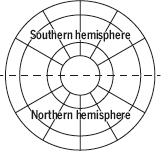
Figure 5: The houses North and South
The top half of the chart is the most visible part of our lives, while the lower half deals more with our private life. The top half of the chart is called the Southern Hemisphere (because the chart’s perspective has us in it, looking out, so the North is ahead of us and the South is behind us). So a person with lots of planets in the top half of their chart lives their life quite openly – they are ‘seen’, they are out in society and they tend to be more outgoing and social.
Conversely, someone with lots of planets in the lower half of their chart (called the Northern Hemisphere), will be more private, perhaps more guarded, more subjective. They most likely prefer to keep themselves to themselves.
Astrologers also break the houses down into Eastern and Western hemispheres (as shown below). The line in the middle represents, and is sometimes called, the horizon.
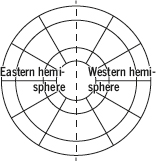
Figure 6: The houses East and West
Again, the Eastern and Western divisions reflect the chart’s perspective – with us on the inside, looking out. People who have more of their planets distinctly on the left, or Eastern, side of the chart tend to be more assertive – they show a lot of initiative, and are motivated self-starters. People with a lot more planets on the right of the chart, the Western side, are usually more oriented towards other people rather than self-focused. They ask less what you can do for them and more what they can do for you. They are often very thoughtful and considerate.
The 12 houses are also divided into four quadrants:
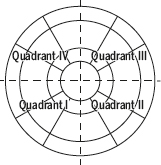
Figure 7: House quadrants
The houses in the first quadrant – houses 1, 2 and 3 – are all about self-awareness: where we discover our own personal identity. Those in the second quadrant – houses 4, 5 and 6 – are about self-expression: how we show the world who we are, and how we integrate with our environment.
The third quadrant – houses 7, 8 and 9 – is the area of self-expansion and social identity. It’s about our awareness of others. The fourth quadrant – houses 10, 11 and 12 – is all about social expression and self-transcendence. It’s about how we integrate with society.
The most important houses in the birth chart are often believed to be the 1st, 4th, 7th, and 10th houses. These are the angular houses, so named because their cusps coincide with the four angles: the ascendant, IC, descendant and MC. The planets in the angular houses may influence you the most.
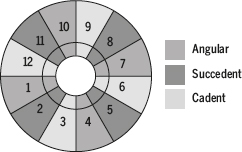
Figure 8: Angular, succedent and cadent houses
The houses that follow the angular houses in the birth chart are the succedent houses. The planets in the succedent houses are less powerful than those in the angular houses, but more powerful than those found in the third category, cadent houses. Succedent planets are effectively ‘on the rise’ – while the word ‘cadent’ means ‘fallen’ and is the root of the word cadaver, meaning corpse. Traditionally, planets here were regarded by astrologers as the weakest.
Note that the 11th house is seen as more powerful than other succedent houses and almost as strong as an angular house. It’s known as the house of good fortune and good spirit.
When you look at your chart, you’ll see that a line separates each of the 12 houses – this is called the cusp or the house cusp. A house cusp is the imaginary dividing line between one house and another. For example, the 2nd house cusp is the dividing line between the 1st and 2nd houses – it’s where the 2nd house starts. The 1st house cusp divides the 12th and 1st houses, and so on.
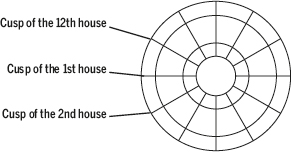
Figure 9: House ‘cusps’
You may have heard the word ‘cusp’ before, in the phrase ‘to be born on the cusp’. When astrologers talk about people being born on the cusp of a zodiac sign, it comes from the same idea of house cusps: they’re referring to someone born on the changeover day when the Sun moves from one sign into another – usually between the 19th and 22nd of the month. Therefore you have the Sun passing over the house cusp.
There’s a common misconception that being born ‘on the cusp’ makes you a bit of two signs. In fact, regardless of whether you were born on the cusp or not, your Sun (and indeed all planets and points) can only ever be one sign or another.
That changeover date varies from year to year, so if you were born on the cusp of a sign you’ll need to find your definitive sign (if you haven’t already done so). You can do this at theastrologybook.com/freechart. You are one sign or another and not a bit of both, even if you were born in the very first or last minute of your sign.
In Chapter 2, you identified the signs that rule the houses on your chart. The sign you have on each house is important because it casts a ‘glow’ over the whole house. Your ascendant, or Rising Sign, is the front door to your chart, so the sign you have on your ascendant is the sign that rules your 1st house.
This is important because the sign on your 1st house then dictates which sign is on your 2nd, 3rd and 4th houses, and so on. So if you’re Scorpio Rising, say, moving one sign along the chart (remember that the signs go around anticlockwise in the order of Aries, Taurus, Gemini, Cancer, Leo, Virgo, Libra, Scorpio, Sagittarius, Capricorn, Aquarius and Pisces), means that Sagittarius rules your 2nd house, and you therefore spend and deal with the 2nd house issues of cash, property and possessions in a Sagittarian manner.
Your 3rd house would be ruled by the next sign, Capricorn. Since Capricorn is the sign of maturity and the 3rd house is your Communications Zone, you would communicate with Capricornian maturity. And so on.
Once you understand this, you can start to understand how people born on the same day but at different times can be so unalike. For example, someone born at 6 a.m. would be likely to have their Sun in their 12th house or their 1st house, whereas someone born on the same day at midday would be more likely to have it in their 9th or 10th house – the person with their Sun in the 12th or 1st house would be a very different character to the person with their Sun in the 9th or 10th house.
What follows is a little more information about the part of life that each of the houses refers to or governs. As you read on, take a look at your own chart. The descriptions here are only the generic meaning of the house – what you also need to do, once you understand the meaning of each house in this sense, is add a layer of information with the characteristics of the sign that rules that house (see the meaning of the signs section).
So for example, Aries ruling your 8th house (which governs sex and cash) will be very different to Virgo ruling your 8th house. If Aries rules your 8th house you’ll express yourself sexually and in joint financial matters like an Aries – that is to say, with vim and vigour and drive and va va voom! Whereas if you have meeker and milder Virgo on your 8th house, you’ll deal with the 8th house matters of sex and joint finances in a more detailed, careful, modest fashion.
The illustration opposite shows the areas covered by each house. This is something you’ll start to remember automatically with practice, so look at it long and often.
Figure 10: The 12 houses
| House | Meaning |
| 1 | Your appearance and the way you come across, your social ’mask’ |
| 2 | Cash, property, possessions and self-esteem, values, material wealth, what you value |
| 3 | Communications, siblings and neighbours, trips, transport, your mind |
| 4 | Home and family, where you feel you belong, emotional foundations, being settled |
| 5 | Romance, creativity and kids, fun, pregnancies, sex, flirting, risk-taking |
| 6 | Daily work, health and routines, being of service to others, alternative health, job situation |
| 7 | Partnerships (business and personal), one-to-one relationships, marriage, alliances, enemies |
| 8 | Birth, death, life’s mysteries, rebirth, renewal, transformation, sex, joint finances |
| 9 | Travel, study and the Great Cosmic Quest, broadening the mind, gaining perspective |
| 10 | Your ambitions and career – how you make your mark, goals, public life, recognition |
| 11 | Friends, social circles, groups and clubs, wishes, spiritual aspirations |
| 12 | Self-sabotage, fear, your dreams, your inner self, secrets, self-transcendence, retreats, meditation, connection |
The 1st house is the initial impression that a person gives when we meet them. As you’ve seen, the 1st house is also the same sign as the Rising Sign; in fact, the Rising Sign dictates which sign is on the 1st house. Traditionally, astrologers have said that this house governs our physical appearance; personally, I’m not convinced by this. For me, it’s far more about superficial appearance – our way of dressing and our style.
Regardless, this is the part of you that people see first when they see you coming. It’s your business card, your website and your brand, rolled into one. Once you know which sign the 1st house is in, looking at the planet that rules that sign can be very educational. From this house, all the others flow.
This is an awesome house, not least because it has a lot to teach us about the energetic connections between self-esteem and money. If you know anything about the Law of Attraction, you’ll be aware that money pretty much manifests in direct relation to how highly we value ourselves, our talents, our services and what we have to offer the world.
This house, then, is about the material – it describes the financial condition and situation of a person’s chart. It’s also about what we hold dear, what we value. For example, are you a quick spender, good with money, or a little tightfisted? It’s a lot to do with your 2nd house: which sign rules it, which planets you were born with in there, and which planets are currently transiting it (more on this later).
The 3rd house is first and foremost about communications. It’s how a person listens, talks, and thinks. It’s to do with everyday life – our neighbours, our siblings, the things we do automatically, and short trips. It’s about letters and books and how you say things, as well as about why you say them. The sign on this house says a lot about how you sound when you speak (as does your Mercury). Do you come across as learned (Capricorn), or intuitive (Pisces), or caring (Cancer) or flippant (Sagittarius)?
Basic education comes into play in this part of the chart, too. This is the house you reason from. But most importantly, it’s the part of your chart where you connect with others and talk to them or exchange with them. In some ways I think of the 3rd house as a really fun part of the chart, because it’s the part where we have coffee with the neighbours and go on little outings and keep busy.
This is the part of the chart that’s all about home and family; it’s about where you feel you belong and the people who feel like family to you. The sign on the house goes a long way to showing what kind of family life you had in the past, and have today, and what sort of home you want to create. If there are family upsets and rifts to be healed, you can look at your 4th house for ideas of where the problems come from and how to fix them.
This house also denotes the womb, and is the ‘cellar’ of your chart – it’s about the past and what you’ve stashed away, down in the cellar of your life (which is why family is also here… the people with whom you shared your past – those who helped shape you). It’s about instinct and where you feel safe. Parents in general and the father specifically are also represented here.
Now we come to the Fun Zone of your chart. This is the part of you that’s associated with romance, creativity and kids (your own or someone else’s). It’s your light-hearted side and what you do on the weekend. It’s where you express yourself and even take some personal risks. It’s the house of flirtation and good times. The sign on the house will show you how you have a good time.
The 5th house is all about love affairs too. Note that the 7th house is about deep love and relationships, which is different. The 5th house is about the chase and the seduction and the delights. It’s about anything you love to do, too, and that includes being creative in any number of ways. Some people are creative in the kitchen, others with computer code. Hobbies come under this house, as do pleasure and fun.
Welcome to the house of work! The 6th house is where we do our daily grind and earn our daily bread. It’s where we do things for other people and perform our work duties. It’s the ‘ticking over’ part of your horoscope, not the most glamorous part, but very useful and practical. It’s also about your routines – including your morning and evening routines and your self-care routines.
This is also the part of your chart that shows how well you do or don’t look after yourself. As a result, the 6th house – traditionally the house of health – has a really alternative health feel: this is where you keep your inner physician, and if they’re handy with a poultice, tincture or some Reiki, so much the better. Pets are also found in this house.
Welcome to the house of love. Actually, it’s the house of partnership as much as it is about love, but let’s face it, the love aspect of the 7th house is pretty compelling. This is the house where you find the descendant (or Love Line). It’s about the Other: the important other people in your life. That’s often your beloved, your ex, or even people who are more like foes than friends but who loom large in your life. It can also show best friends, business partners and bosses. It’s anyone who is a VIP in your life.
The 7th house is a bit like the 7th sign of Libra, and all about how we relate to other people. Me and you; me versus you; I see me through your eyes. It can show our ideal self: the person we would love to be (as opposed to the ascendant, which shows how we come across, like it or not!). It’s a ’you and them’ place, and it’s where you claim people as ‘my boyfriend’ or ‘my husband’. The sign on this house can say a lot about the people you fall in love with. This is where we make commitments to the people we were only flirting with back in the 5th house.
For me, this is a sinister house – if you go through ancient astrological manuscripts you’ll find all manner of freaky writings about death. The 8th house was once the house of death, but these days we think of it in more enlightened terms: the house of death and rebirth, for instance. That brings a sort of Buddhist feeling into this otherwise slightly frightening domain. Think of it as the house where you have the phoenix rising from the ashes; the leaves that wither and disappear into the soil, only to be reabsorbed and later brought back to life when another plant flourishes there.
It’s also about sex. Sex and death? Well, the French call sexual orgasm ‘La petite mort’ – the little death: go figure. The 8th house is about where we let go, which we also do in sex. It’s funny, because this part of the horoscope is also traditionally about shared finances, such as credit card debts and salaries and even mortgages, which you might think go in the 4th house but actually live here. If you’re doing a joint venture with someone, you’re doing your 8th house. This is also the house of taboos: anything you don’t like to talk about, like sex, death and taxes, goes here.
This is the Adventure Zone in your chart. It’s long-distance travel and where you go off on quests to discover the world. It’s also the part of your chart where you go on cosmic quests, hoping to understand life and its mysteries. As a result, the 9th house is also associated with life philosophies.
It’s also the Study Zone, when people move into higher education or broaden their mind in any way. This is the place in the chart where people see the proverbial Bigger Picture. For that reason, I also think of it as the ‘Count Your Blessings Zone’. The sign on this house will give you an idea of your attitude to travel. It’s also associated with legal matters.
This is the top point or pinnacle of your chart. The MC is the cusp of the 10th house in other house systems, but as we’re using Whole Sign houses, the MC will float into other houses. It talks about what you came into this world to achieve and how you’re going to attempt to pull that off. This should show how you’ll make your mark and where you’ll stand in society. Your status. Do you feel as if you were brought to this Earth to achieve great things? Look to your chart and your 10th house.
If someone wants to ask you about their professional life, look to their 10th house. How lofty are their ambitions? You can work that out by looking at this part of the chart. Which sign rules it? Which planets are in there? Many people are very at home with the 6th house, which is the part of the horoscope where the daily toil goes on. But the 10th house is where our career trajectory lies, and where we decide how ambitious we are. It’s how we stand out and make our mark, even if we don’t actually work a day in our lives. This house covers our reputation.
This house is all about your friends, the social circles you move in and the social networks you belong to: and about how well you’re connected on there. It’s about the people you associate and hang out with. It’s about the company you keep and the people who feel like kindred spirits. It’s about being a part of a team, and how well you can fit in to that role. It’s about your peers.
What kind of friend you are will show up in your 11th house. Do you learn lots of life lessons via your friends? If so, Saturn could rule or be in your 11th house. Do you really adore your friends and vice versa? Perhaps Venus is in your 11th house. Are friends your focus? You may have an 11th house Sun.
When this house is triggered (e.g. if there is a New or Full Moon, or a planet is in there and aspecting other planets), issues related to friends often come up. This part of the chart is also about your ideals – the things you aspire to. Hopefully you’ll find friends who will be aspirational rather than a bad influence. And the 11th house is about what ye olde astrologers would call The Thing Wished For. In other words, this part of your chart is about what you’re wishing for.
This is the part of your chart where you can withdraw, rest and retreat. It’s the place you go when you’ve had enough and you need to refuel on energy or positive emotions. The planet and sign on the cusp of the 12th house will say a lot about how you do that. This is also, somewhat scarily, known as the house of self-sabotage, so be aware of that. Getting to know your 12th house will show you how you shoot yourself in the foot and how to stop doing that.
It’s also the part of your chart where you keep a big connection to your spiritual life. Traditional astrologers won’t agree, but many modern astrologers associate the 12th house with the planet of poetry and Divine connections, aka Neptune: the planet associated with Pisces since its discovery in 1846. For me, it’s the deepest, darkest and most private part of your chart, and it’s the place we tap into when we connect with the other dimensions. It may sometimes be associated with suffering and sacrifice, but it’s also to do with the angels and guides who help us through tough times.
Once you know a person’s ascendant (Rising Sign), it’s easy to work out the rest of their houses, as all the zodiac signs follow in the traditional order in an anticlockwise direction. The sign that’s on a house cusp flavours the matters related to that house.
So here’s a guide to your houses – a quick way for you to work out which sign rules which house in your chart and what that means.
Make a note of which houses your planets are in.
Go through your chart and see which planet is in which house, then memorize the information below on how this plays out in your life.
My Sun is in my ______ house. This is where I shine.
My Moon is in my ______ house. This is what I need.
My Mercury is in my ______ house. This is what’s on my mind a lot.
My Venus is in my ______ house. This is what I love.
My Mars is in my ______ house. This is where I fight.
My Jupiter is in my ______ house. This is where I’m luckier.
My Saturn is in my ______ house. This is where my lessons come from.
My Uranus is in my ______ house. This is where I’m subject to change.
My Neptune is in my ______ house. This is where I’m inspired, or where I may wear blinkers.
My Pluto is in my ______ house. This is where I’m ripe for transformation.
In this chapter, we’ve delved into deeper astrology via the 12 houses. You’ve now learned about the divisions of the horoscope and how important the houses are. You know that the 12 houses are divided into three subsections of angular, succedent and cadent. Plus, you’ve seen what each house means. You’ve also learned about the importance of checking to see which sign is on which house. This is all vital information for you to take in and work with.